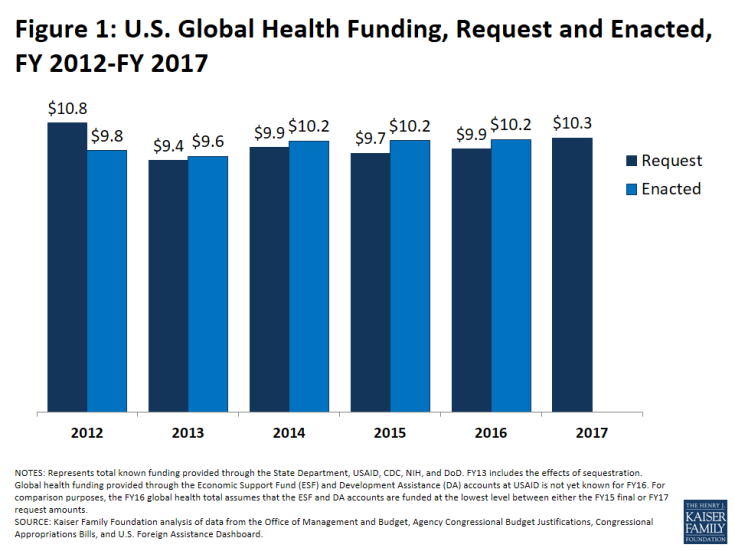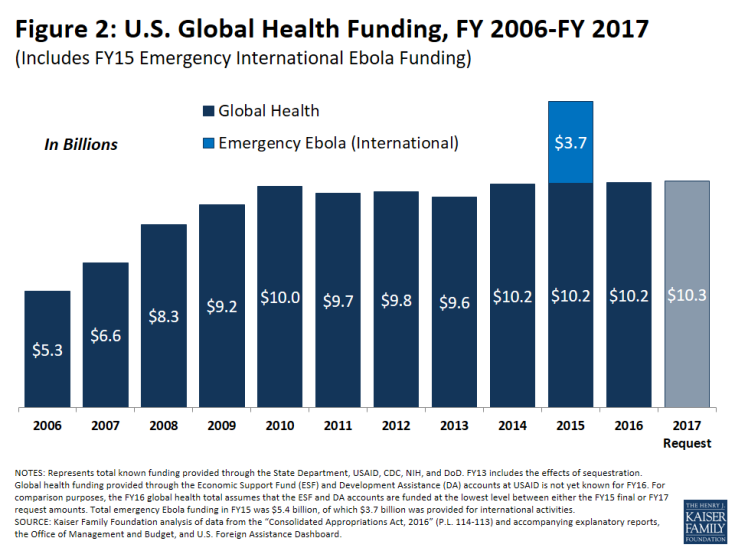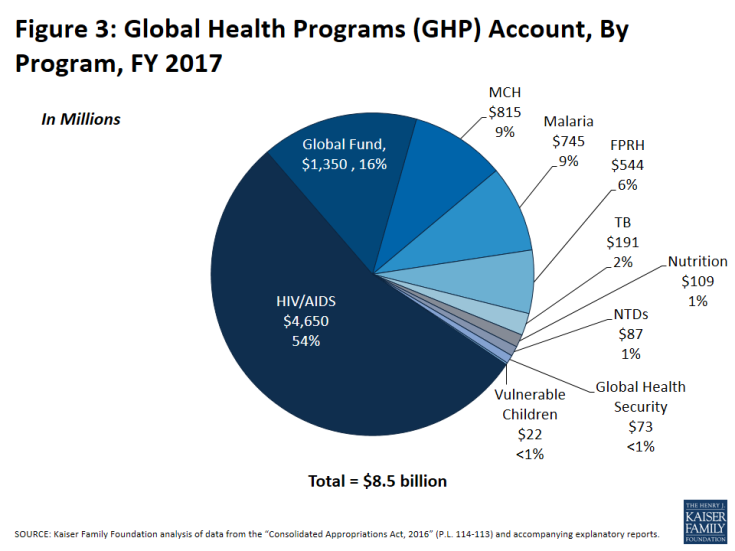The U.S. Global Health Budget: Analysis of the Fiscal Year 2017 Budget Request
Overview
President Obama released the budget request for Fiscal Year 2017 (FY17) on February 9, 2016, his final budget request in office, which included $10.3 billion in total funding for global health programs. This marks the first time in three years that the request for global health is higher than the previous year enacted level, and represents the largest request since FY12 (see Figure 1). If enacted by Congress, it would represent the highest level of global health funding to date (excluding emergency funding for Ebola provided in FY15) (see Figure 2).
The majority of U.S. global health funding is provided as part of base funding for ongoing programs under the international affairs budget, which includes programs at the U.S. Agency for International Development (USAID) and the Department of State.1 While the FY17 request proposed increased funding for global health, it proposed decreased base funding for the international affairs budget. As a result, when measured as a share of the international affairs budget, global health would continue the recent trend of increasing as a share of the international affairs budget rising from 20% in FY14 to 23% in FY17 (see Table 1).
Within the international affairs budget, most of the global health funding ($8.6 billion) specified in the FY17 request is provided through the Global Health Programs (GHP) account at USAID and the State Department, which includes funding for the President’s Emergency plan for AIDS Relief (PEPFAR) and the President’s Malaria Initiative (PMI), as well as other global health programs (see Figure 3). Within the GHP account, three programs increased compared to FY16: malaria, maternal and child health (MCH), and family planning and reproductive health (FP/RH); four areas decreased: tuberculosis (TB), neglected tropical diseases (NTDs), nutrition, and vulnerable children; and three areas remained flat: bilateral HIV, the Global Fund to Fight AIDS, Tuberculosis, and Malaria (Global Fund), and global health security (see Figure 4).
As Congress reviews the President’s budget request for FY17 and begins drafting appropriations legislation, it is important to note that Congress has approved higher funding levels for global health than those in the President’s budget request in each of the last four fiscal years (FY13-FY16). Whether Congress will continue this trend or change funding levels for specific program areas is not yet known.
Funding by Program
This section provides an overview of global health funding levels by program area as specified in the FY17 budget request (unless otherwise stated, all comparisons are to FY16 enacted levels) (see Table 2).
PEPFAR/Bilateral HIV
PEPFAR’s bilateral HIV funding through the GHP account totaled $4,650 million in the FY17 budget request ($330 million at USAID and $4,320 million at the State Department), matching the FY16 level, but $309 million less than its peak level of funding ($4,959 million) provided in 2010. Bilateral HIV accounted for the largest share (54%) of any program area within the global health portfolio under the GHP account, although it has declined in recent years from a high of 69% in 2008. It included funding for microbicides research ($45 million) and the U.S. contribution to the Joint United Nations Programme on HIV/AIDS (UNAIDS) ($45 million). The request also included $128.4 million in HIV funding through the Centers for Disease Control and Prevention (CDC), $8 million for HIV programs at the Department of Defense (DoD), and $431.9 for HIV research at the National Institutes of Health (NIH); HIV funding through these three agencies essentially matches FY16 levels.
Global Fund to Fight AIDS, Tuberculosis and Malaria (Global Fund)
The President’s request included $1,350 million for the U.S. contribution to the Global Fund, matching the FY16 level, which was $300 million below the peak level of $1,650 million provided in FY14. The Global Fund accounts for the second largest share (16%) of U.S. funding for global health (in the GHP account).
Tuberculosis (TB)
Funding for TB programs through the GHP account totaled $191 million, a $45 million decrease (19%) below the FY16 level. Tuberculosis funding is also provided through the Economic Support Fund (ESF) account which totaled $4.0 million in the FY17 request (tuberculosis funding provided through the ESF account in FY16 is not yet known; in FY15, it was $6.3 million).2 Additional support for TB programs is provided through bilateral HIV programs (GHP account) at the State Department to address TB/HIV co-infection.3
Malaria
Malaria funding totaled $745.0 million in the FY17 request and was one of only three program areas under the GHP account that increased above FY16 levels (an increase of $71 million or 11%). In addition to increased funding for malaria provided through the GHP account, the FY17 request proposed a transfer of $129 million from the emergency Ebola funding provided by Congress in FY15 to address malaria. If the transfer of Ebola funding is approved by Congress, this would bring total malaria funding to $874 million in FY17, an increase of $200 million (30%) above the FY16 level. The budget request also included $10.7 million in malaria funding through the CDC, $7.0 million at DoD, and $171.0 million for malaria research activities at the NIH. The FY17 request for malaria funding at CDC and NIH match the FY16 levels, while DoD funding is a slight increase.
Family Planning & Reproductive Health (FP/RH)
The FY17 request included $585 million in total bilateral funding for FP/RH, an increase of $10 million (2%) above the FY16 level. This includes $544 million through the GHP account and $41 million through the ESF account.4 FP/RH was one of only three program areas to increase under the GHP account. The request also included $35 million for the U.S. contribution to the United Nations Population Fund (UNFPA), an increase of $2.5 million (8%) above FY16 levels, but $20 million less than its peak level of funding ($55 million) provided in 2010.5
Maternal & Child Health (MCH)
MCH was one of the three programs that received increased funding through the GHP account in the FY17 request, totaling $814 million, a $64 million (9%) increase above FY16 levels. This includes $540 million in funding for bilateral programs, a $25 million (5%) increase above FY16 levels, and a $275 million contribution to GAVI, a $40 million (17%) increase above FY16 levels. Additional MCH funding provided through the ESF account totaled $105.2 million (MCH funding provided through the ESF account in FY16 is not yet known; in FY15, it was $116.6 million). Funding for global immunization programs at CDC totaled $224.0 million, an increase of $5.0 million (2%) above the FY16 level.
Specific components of MCH funding provided through USAID as well as CDC and the State Department are as follows:
- GAVI: The U.S. contribution to GAVI, which is included under MCH funding in the GHP account, totaled $275 million, a $40 million (17%) increase above FY16.
- Polio: U.S. funding for polio programs is provided through USAID (as part of MCH funding via the GHP and ESF accounts) and CDC. Polio funding totaled $51.7 million at USAID, a $7 million decrease (12%), and $174 million at CDC, a $5 million (3%) increase above FY16 levels.
- United Nations Children’s Fund (UNICEF): The U.S. contribution to UNICEF totaled $132 million in the FY17 request, which essentially matches FY16 levels.6
Nutrition
Nutrition funding through the GHP account totaled $108 million in the FY17 request, a decrease of $16 million (13%) below the FY16 level. Additional nutrition funding through the ESF and Development Assistance (DA) accounts totaled $36.5 million and $9.9 million, respectively (nutrition funding provided through these accounts in FY16 is not yet known; in FY15, $21.2 million was provided through the ESF account and $1.0 million was provided through the DA).
Vulnerable Children
Funding for vulnerable children, which is provided via the Displaced Children and Orphans Fund (DCOF) at USAID, totaled $14.5 million in the GHP account in the FY17 request, a decrease of $7.5 million (34%) below the FY16 level.
Global Health Security
The Global Health Security Agenda (GHSA), an effort launched in February 2014 aimed at improving global capabilities to prevent, detect, and respond to epidemics and other emerging public health threats, includes funding from multiple agencies. At USAID, funding for Global Health Security (formerly Pandemic Influenza and Other Emerging Threats) is provided through the GHP account and totaled $72.5 million in the FY17 request, matching FY16 levels. Funding for Global Public Health Protection at CDC, which includes funding for Global Disease Detection and Emergency Response as well as Global Public Health Capacity Development, totaled $65.2 million, an increase of $10 million (18%) above FY16 levels.
Other Global Health Funding
The U.S. provides additional global health funding in support of water, sanitation and hygiene (WASH) activities, for international global health research efforts conducted through the Fogarty International Center (FIC) at NIH, and for multilateral organizations, such as the World Health Organization (WHO) and the Pan American Health Organization (PAHO), that play an important role in addressing global issues. The FY17 request included $255.6 million in funding for WASH activities provided through multiple accounts and programs (since WASH is considered a cross-cutting issue supported through direct funding as well as funding provided through other programs, such as HIV and MCH, it is not included within the overall global health total in order to prevent double-counting).7 The FY17 request included $69.2 million for international global health research activities at FIC, essentially matching FY16 levels. The request also included a $113 million contribution to WHO and a $63 million contribution to PAHO, essentially matching FY16 levels.
Other International Development Programs
The FY17 request included funding for areas and agencies that are not directly involved in U.S. global health, but are related and may impact these efforts including: the Millennium Challenge Corporation (MCC), which is an independent U.S. foreign assistance agency that has the goal of reducing poverty in developing countries through supporting economic growth; Feed the Future (FtF), which is the U.S. Government’s Global Hunger and Food Security Initiative (GAFSP); broader food assistance through Food for Peace (FFP) and McGovern-Dole International Food for Education and Child Nutrition (McGovern-Dole); and other funding through the State & Foreign Operations Economic Support Fund (ESF) and Development Assistance (DA) accounts. Funding for the ESF account and the DA account both increased compared to FY16 levels.2 The FY17 request included $1,000 million for MCC, an increase of $99 million (11%). Funding for FtF, GAFSP, FFP, and McGovern-Dole all decreased compared to FY16 levels (see Table 3).
Acronym List |
|
| AEECA | Assistance for Europe, Eurasia and Central Asia |
| CDC | Centers for Disease Control and Prevention |
| DoD | Department of Defense |
| DA | Development Assistance |
| DCOF | Displaced Children and Orphans Fund |
| ESF | Economic Support Fund |
| FP/RH | Family Planning and Reproductive Health |
| FtF | Feed the Future |
| FIC | Fogarty International Center |
| FFP | Food for Peace |
| GAFSP | Global Hunger and Food Security Initiative |
| GHP | Global Health Programs |
| GHSA | Global Health Security Agenda |
| MCC | Millennium Challenge Corporation |
| MCH | Maternal and Child Health |
| NIH | National Institutes of Health |
| NGOs | Non-Governmental Organizations |
| PAHO | Pan American Health Organization |
| PEPFAR | President’s Emergency Plan for AIDS Relief |
| PMI | President’s Malaria Initiative |
| SFOPs | State & Foreign Operations |
| TB | Tuberculosis |
| USAID | U.S. Agency for International Development |
| UNAIDS | Joint United Nations Programme on HIV/AIDS |
| UNICEF | United Nations Children’s Fund |
| UNFPA | United Nations Population Fund |
| WASH | Water, Sanitation and Hygiene |
| WHO | World Health Organization |




